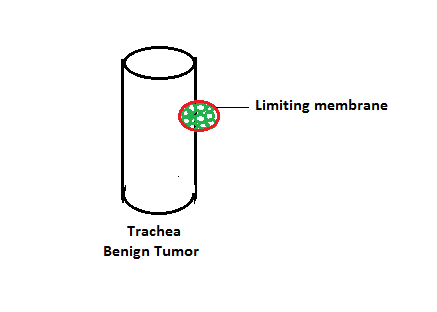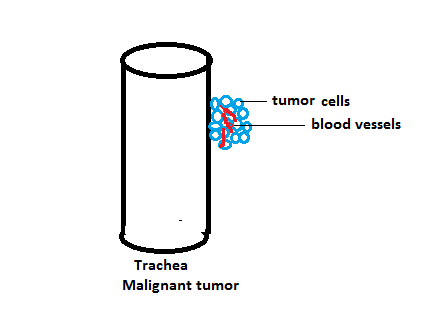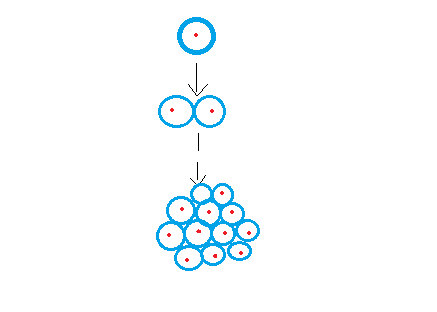Introduction to Cancer
Uncontrolled cell division in the body leads to the formation of tumor. However, there are two kinds of tumor, the first type is benign tumor and the second type is malignant tumor. Only malignant tumor is associated with cancer. It is important to understand the basic difference between banign and malignant tumor.
Difference between Benign Tumor and Malignant Tumor

Let’s understand the difference between benign and malignant tumor by taking an example of trachea. Suppose, on the outer wall of trachea, uncontrolled cell division occurs and a cluster of cells is formed. This cluster of cells are bounded by a membrane, meaning all cells would be present inside a single membrane, called the limiting membrane. This type of tumor is called benign tumor. There are certain characteristics of benign tumor. They are localized, meaning it will remain at one place and does not spread in the body due to the presence of a single limiting membrane.

In case of malignant tumor, the same cluster of cells would form (say, on the outer wall of trachea). However, the limiting membrane in this case would rupture and the tumor cells would grow in size and blood vessels would also proliferate. Due to the presence of blood vessels, some of these tumor cells would enter the blood vessel and spread to other parts of the body. The ability of spreading of tumor cells to different parts of the body through blood vessels is called metastasis. And such tumors are called malignant tumors.
Why Cancer is a Problematic Disease?
One of the biggest problems with malignant tumor is that it is very difficult to diagnose in its initial stage. For example, if a tumor is formed on the outer wall of the digestive tract, it would not hamper the digestion. All physiological processes would continue without any problem. And a person in general visits a doctor only when the problem arises in the body.
By the time, a problem arises in the body related to cancer, the tumor cells, which were benign in the beginning become malignant and spread to different parts of the body. So, even after the removal of the tumor, its very difficult to get rid of it completely because the tumor cells have already spread to different parts of the body.
The next problem with malignant tumor is that it does not have any definitive symptoms. Other diseases such as typhoid, malaria, tetanus, mumps, all have definitive symptoms. In case of cancer, for instance, if a tumor is formed on tracheal wall, it would press the oesophagus wall on the dorsal side, this might cause a problem in swallowing; if a tumor is formed in the prostate, it would cause problems in micturition. These are general problems and do not point to a specific disease.
Properties of Cancer cells
- Divide in uncontrolled manner
- Life span is not definite. All other cells of the body have a specific life span.
- Extracellular growth factors are not required
- Nucleus becomes irregular
- Number of lysosomes increases
- Don’t have a property of contact inhibition
- Don’t respond to normal growth control mechanism
- Invade and destroy surrounding tissues
One of the main properties of malignant cells is that they don’t show contact inhibition. Now, the question is what do you mean by contact inhibition. Well, when a cell divides, it comes in contact with the newly formed cells. For example, if a cell divides into two, the two cells would get in touch with each other through plasma membrane. Likewise, when cells divide continuously, the central cell would get in touch with its neighboring cells and would cease to grow further. This is called contact inhibition.

In the picture shown above, one can see that there are many cells surrounded by other cells. The more a cell is surrounded by neighboring cells, the more it loses the capacity to grow. Now the question arises, why contact inhibition is necessary? Well, if contact inhibition would not persist, organs such as liver, kidney and other organs would grow continuously, but it does not happen and that is because of contact inhibition. Every cell in an organ has a limit to grow. However, in cancerous cells, they lose the ability of contact inhibition and that is why cells continue to divide and grow in size.
Types of Cancer
- Carcinoma: mainly derived from epithelium. About 80 percent of reported cases of cancer fall under carcinoma, cervical cancer, breast cancer and skin cancer.
- Sarcoma: This is a type of cancer of mesodermal origin. Examples include osteoma, lymphoma, and Hodgkin’s disease.
- Leukemia: Abnormal increase in WBC (White Blood Cells). Leukemia is also known as blood cancer.
Causes of Cancer
- Carcinogens:Chemical and physical agents that can cause **malignant tumors**. Physical irritants include tobacco chewing, smoking, Kangri basket, etc. On the other hand, chemical agents include soot (causes skin or lung tumors), coaltar (causes skin or lung tumors), Cadmium oxide (causes prostate tumors), vinyl chloride (induces tumors of the liver), DES (diethylstilbestrol) — induces tumors in the vagina.
- Biological agents: there are plenty of viruses involved in causing cancer. For instance, hepatitis B virus (HBV) causes liver cancer, HIV causes cancer
- Radiations: Harmful radiations might cause cancer
- Genes: mutation in genes also causes cancer
Possible Symptoms
- Persistent cough or hoarseness
- persistent change in digestive or bowel habits
- A lump or hard area in the breast
- A change in wart or mole
- Unexplained loss of body weight
- Incurable ulcer
- Bleeding from mouth/nose/skin
Treatment of Cancer
Surgery — surgical removal of tumor
Radiation therapy — Exposure of cancerous parts of the body to X-ray, radioisotopes are used
Chemotherapy — anticancer drugs such as Vinblastin and vincristine obtained from Catharanthus roseus
Immunotherapy — Monoclonal antibodies are used

